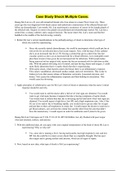Case Study Shock Multiple Cases.
Huang Mei Lan is a 43 year old unmarried female who lives alone in a major We st Coast city. Three years ago she was diagnosed with breast cancer and underwent a mastectomy of the affected breast and follow up chemotherapy. Last month, Ms. Lan experienced a recurrence of cancer in the lymph glands of the affected side. Surgery to remove the glands was performed and chemotherapy started. Ms. Lan has a central line, a urinary catheter, and a surgical incision. The nurse enters Ms. Lan’s room and find her huddled in the middle of the bed shivering violently. 1.Relate Ms Lan’s current manifestations to the pathophysiology of shock to determine what type of shock she could be experiencing. Since she recently started chemotherapy, she could be neutropenic which could put her at
risk at risk for an infection due to her recent surgery. Also, with having a Foley catheter she is at an increased risk for a UTI. Having a central line gives a direct line into her vascular system so she is at an increased risk for a blood infection. Low neutrophil count plus these invasive lines gives her an increased risk for infections. With lymph nodes being removed on her surgical side, means she has an increased risk for infection on that side. With the patient shivering out of control, and just having chemo and surgery, I could
most likely determine that it is septic shock that she is experiencing. With septic shock, when bacteria enters the blood, there is an inflammatory response. This causes vasodilation, decreased cardiac output, and cool extremities. This is due to leukocyte lysis that causes release of histamine, serotonin, lysosomal enzymes, and kinins. This causes the inflammatory response and fluid buildup in extremities. This would cause her shivering.
2.Apply principles of collaborative care for Ms Lan’s form of shock to determine what the nurse’s initial response should be and why. You would want to call the doctor after a full set of vital signs are obtained. You would want to get vital signs because it appears that she is having symptoms of septic shock. You would want to inform him that she is shivering and let him know what vital signs are
obtained. You would expect a high fever, low BP, and a high respiratory rate. Also, if her
O2 sat is low and/or she is breathing rapidly, you would want to get an order for oxygen and put that on then call respiratory to assess her. I would expect the doctor to want me to
get blood cultures, one set from the central line and the other from the arm that didn’t have the mastectomy. I would expect an order for antibiotics and Tylenol to be given. Huang Mei Lan Vital signs are: T 104, P 110, R 30, BP 106/66 Skin- hot, dry flushed with poor turgor Alert and oriented, restless, and anxious 3.With this additional data, do you agree with your original interpretation of the kind of shock Ms Lan is experiencing? Why or why not? Yes, since she is running a fever, having tachycardia, has high respiratory rate, and low BP, but she could be in a more severe shock than we originally thought. She has poor skin turgor and is getting restless and anxious, which are all signs of sepsis. 4.Now, based on new data, what type of shock is Ms Lan experiencing? She is experiencing sepsis.
5.What stage of shock is Ms Lan experiencing? Severe sepsis
6.What would be the expected laboratory tests for Ms Lan? Blood cultures from the central line and one from non-surgical side arm. Also, a CBC with platelets, which would include her white count with differentials. They also might want to do a CMP to look at her kidney function. I may see a DIC Panel, activated protein C, lactic acid level, and ABGs done.
7.Apply principles of collaborative care for clients experiencing shock to determine what are, in general and specific to Ms Lan, the expected medical/pharmaceutical treatment/interventions? I would expect the doctor to order IV fluids, oxygen, and antibiotics. I would see vasoconstrictor and inotropic agents and possible steroid therapy through her IV for inflammation management. I would expect more frequent vital signs to be taken and maybe have her moved to the ICU so she can have 1 on 1 care. Insulin may be prescribed
to maintain normoglycemia. The appropriate medical/pharmaceutical interventions have been implemented for Ms Lan. 8.Discuss nursing implication for treatment and medications prescribed for Ms Lan’s type of shock. Oxygen to maintain oxygen levels and help with her rapid breathing. Oxygen demands increase with sepsis.
IV fluids to maintain good BP, make sure she does not become hypovolemic, and prevent
kidney failure. We want to make sure that we aren’t overloading the patient with fluids by watching for edema and crackles in the lungs.
Vasoconstrictors to help increase BP. Antiobiotcs to help treat the infection. Insulin to maintain a normal glucose level. We want to make sure the BP doesn’t get too high.
Steriods to decrease inflammation. We want to monitor blood sugars in the patient. 9.Utilize the data in the preceding question to develop and prioritize a list of nursing diagnoses with 3 nursing interventions and one outcome criteria for Ms Lan. Risk for hyperthermia
oMeasure and record vital signs every hour
oWork with the doctor to help determine the cause of the temperature increase
oRecognize that hyperthermia is a rise in body temperature above 40º C
oOUTCOME: Maintain body temperature below 40º C
Risk for fluid volume deficit




